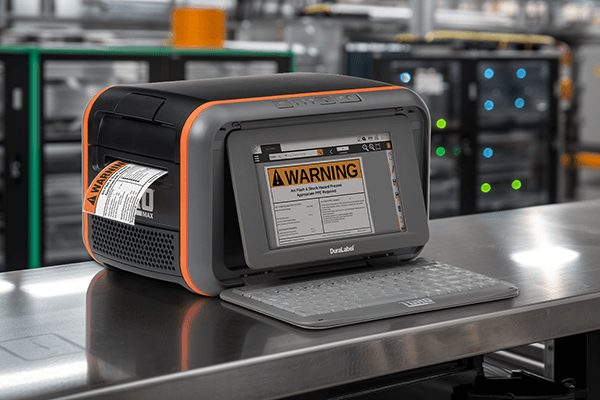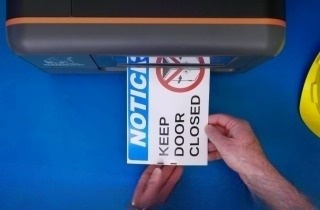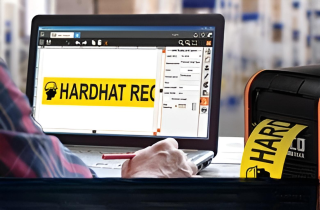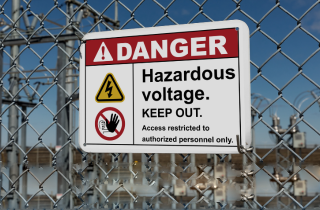Arc Flash Labeling Essentials for Industrial Facilities & Field Teams

What Makes Arc Flash Labeling Essential for Electrical Safety?
A loud explosion. A sudden flash of blinding light. Blistering heat. These are the terrifying symptoms of an arc flash incident, one of the most dangerous and costly hazards in any electrical environment. Whether working in a manufacturing plant, data center, or power distribution facility, employees are exposed to the risk of arc flashes when energized electrical equipment is involved.
The consequences of an arc flash can be catastrophic. Without proper safeguards and accurate labeling, workers may not realize they’re walking into a high-risk zone. Arc flash labeling is a critical component of facility safety, providing essential information that protects personnel, reduces risk, and supports compliance.
Why Arc Flash Labeling Matters

Arc flash labeling plays a vital role in any workplace that operates or maintains electrical systems. These labels communicate vital details about potential electrical hazards, such as available incident energy, arc flash boundaries, and required personal protective equipment (PPE). When done properly, arc flash labeling enhances situational awareness and gives technicians the information they need to work safely.
Organizations that prioritize arc flash compliance also demonstrate a commitment to safety best practices and regulatory adherence. Proper labeling helps reduce workplace injuries, prevent equipment damage, and minimize downtime. It’s not just a matter of avoiding fines—it’s a matter of protecting lives.
Understanding NFPA 70E and Arc Flash Compliance
The National Fire Protection Association (NFPA) developed NFPA 70E to establish safe work practices for electrical maintenance and service. While the Occupational Safety and Health Administration (OSHA) sets legal requirements, NFPA 70E outlines how to comply with those mandates, especially regarding arc flash hazard assessment and communication.
Under NFPA 70E, employers are responsible for conducting arc flash risk assessments and applying arc flash labels to any electrical equipment that may require examination, servicing, or maintenance while energized. Key elements include:
-
Incident Energy: The amount of energy a worker may be exposed to at a specific distance during an arc flash.
-
Arc Flash Boundary: The distance at which an individual could receive second-degree burns from an arc flash.
-
PPE Category or Requirements: Information on what level of protection is required to work on the equipment safely.
These elements must be listed clearly and legibly on each arc flash label. In addition, arc flash labeling should be reviewed and updated anytime system changes are made or every five years, whichever comes first.
Labeling for Real-World Risks: Common Electrical Hazards
Arc flashes occur when electrical current deviates from its intended path, often due to equipment failure, dust, moisture, or accidental contact. These events can result in temperatures exceeding 35,000°F and pressure waves strong enough to rupture eardrums or hurl objects across a room.
Workplaces must treat these risks seriously. Clear, consistent arc flash labeling helps workers recognize areas where electrical hazards exist. Technicians know when to stay back, what PPE is required, and which procedures to follow. Without those visual warnings, the chance of severe injury or even fatality increases exponentially.
That’s why labeling is more than a formality—it’s a vital part of daily operations in any facility that deals with energized electrical systems.
Creating Arc Flash Labels with an Industrial Printer

Creating effective arc flash labels requires more than just the right wording. Labels must be durable, legible, and compliant with NFPA 70E standards. That’s where an industrial printer designed for safety labeling comes into play.
Using an industrial printer enables teams to:
-
Print on durable vinyl that withstands heat, moisture, and abrasion.
-
Customize labels on demand for different panels, machinery, and equipment.
-
Standardize design and format using built-in templates that align with compliance standards.
For example, the DuraLabel Toro Max Industrial Sign and Label System offers portability and power for teams that need to label electrical panels both in the shop and in the field. When used alongside compliance-ready software, it simplifies the labeling process and helps maintain consistency across facilities.
Using LabelForge PRO Design Software for Electrical Hazards
A robust arc flash labeling system is only as effective as the software that supports it. That’s why DuraLabel developed LabelForge PRO Design Software, a powerful, intuitive platform for creating OSHA- and NFPA-compliant labels.
LabelForge PRO comes preloaded on DuraLabel printers like the Toro Max, or it can be installed on your PC for desktop use. With LabelForge PRO, safety professionals can:
-
Access a large database of electrical hazard symbols and templates.
-
Create custom arc flash labels with accurate incident energy data.
-
Automatically apply formatting that meets NFPA 70E requirements.
-
Save and edit templates for repeat jobs across multiple facilities.
Unlike generic design software, LabelForge PRO was built specifically for industrial labeling needs. Whether you’re tackling a new arc flash compliance project or updating aging labels, this software eliminates guesswork and accelerates workflows.
What Should Be on an Arc Flash Label?
Effective arc flash labels deliver the right information at a glance. According to NFPA 70E, here are the four essential components:
-
Nominal System Voltage: The operating voltage of the equipment.
-
Arc Flash Boundary: How close a person can be before PPE is required.
-
Incident Energy or PPE Category: Data used to select proper protective gear.
-
Label Date and Responsible Person: Indicates when the label was last updated and by whom.
Some facilities also choose to include additional information, such as working distance, shock hazard data, and equipment ID numbers. While these aren't mandated, they improve clarity and traceability.
Maintaining Arc Flash Compliance
Compliance isn’t a one-time task. Facilities must regularly update arc flash labels to reflect system changes, retrofits, or modifications. This is essential not only for arc flash compliance but also for protecting employees from outdated or incorrect safety information.
Regular audits, recordkeeping, and training go hand-in-hand with arc flash labeling. Workers should be trained to interpret labels and understand what actions to take when they see specific PPE or hazard warnings.
Using a centralized labeling platform, like LabelForge PRO, allows safety teams to manage these updates efficiently and keep everything consistent, even across multiple sites.
DuraLabel Tools for Better Arc Flash Labeling
LabelForge PRO Design Software gives safety professionals the control and confidence they need to produce accurate, compliant arc flash labeling. With a built-in symbol library, compliance-ready templates, and formatting that aligns with NFPA 70E standards, LabelForge PRO simplifies labeling workflows and reduces the risk of human error. Whether installed on a desktop or used with a DuraLabel Industrial Sign and Label System, this free software brings clarity and consistency to any electrical safety program.
For teams working in harsh or remote environments, the DuraLabel Toro Max Arc Flash Outdoor Kit offers everything needed for reliable, on-the-go labeling. This rugged, all-in-one kit includes the DuraLabel Toro Max Industrial Sign and Label System, arc flash supply, and a durable carrying case built to handle demanding field conditions. With built-in LabelForge PRO software and no PC required, it’s a powerful, portable solution for meeting arc flash compliance requirements wherever hazards exist.
Want a quick reference for what goes on a compliant arc flash label? Download DuraLabel’s Arc Flash Label Requirements Chart—a free resource that outlines key elements like incident energy, boundaries, PPE, and more. Get the chart here and make accurate labeling easier for your team.
Still have questions about arc flash labeling? Call 1-888-411-3520 and one of our experts can help!
Read Next
How Booth & Associates Utilized Arc Flash Labeling for Client Service
Why Electrical Engineers Need LabelForge PRO for Consistent Compliance
Related Resources

The Overlooked Fix That Improves Electrical Panel Safety
How Do Electrical Panel Labels Improve Safety and Compliance? Electrical panels are essential to every ...
Read
What Every Engineer Should Know About Preventing Arc Flash Incidents
How Can Labeling Help Prevent and Arc Flash Incident? An arc flash incident occurs when electrical current ...
Read
NFPA 70E Arc Flash with OSHA Signs
What is NFPA 70E? NFPA 70E, or the NFPA’s Standard for Electrical Safety in the Workplace, outlines specific ...
Read.png)





